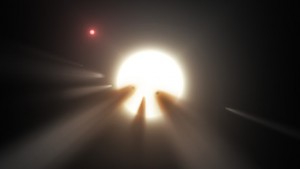If you’re looking for a guide to this series, click here.
The central puzzle of Boyajian’s Star is that although the dips look a lot like those of dippers, it has no close-in disk. That is, most stars that show this sort of behavior are young and have close-in disks, and those disks cause their dips. Not only does Boyajian’s Star have no close-in disk, it isn’t near a star forming region, so there is no reason to think it is young, anyway.
So, if it can’t have close-in material, what could be causing the dimmings? Well, if the material is circumstellar, it must be very cold, and/or there can’t be very much of it. Boyajian et al. also showed that the timings and slopes of the dips also put constraints on the material’s proximity to Boyajian’s Star, meaning it needs to be pretty far-out (10 AU or so). This brings us to:
Hypothesis 7) Comets or other circumstellar debris
 Boyajian’s original hypothesis was that the dips were caused by giant swarms of giant comets. This remains a plausible hypothesis for the dips: the comets would certainly have been warm when near periastron, but their eccentric orbits could bring them very far from the star quite quickly. Thus, the infrared excess would only be noticeable during a dip. If the swarm is on a long-period orbit, then we may never see them again!
Boyajian’s original hypothesis was that the dips were caused by giant swarms of giant comets. This remains a plausible hypothesis for the dips: the comets would certainly have been warm when near periastron, but their eccentric orbits could bring them very far from the star quite quickly. Thus, the infrared excess would only be noticeable during a dip. If the swarm is on a long-period orbit, then we may never see them again!
On the other hand, there doesn’t seem to be any way the comets can explain the long-term dimming, especially without an infrared excess.
So, my subjective verdict on this is: plausible for the dips, very unlikely for the long-term dimming. Occum’s razor argues that if they aren’t causing the long-term dimming, then they probably aren’t causing the dips, either, but your mileage may vary on that one.
OK, what about:
Hypothesis 8) A cool annulus of material
 This is basically the hypothesis that there is a disk of material, but there is a very large (10 AU, at least) gap between the star and the inner edge of the disk (annulus). The disk is almost, but not quite, edge-on: then, we could invoke corrugation or other irregularities that occasionally block part of the star for the dips. This needs to be a real protoplanetary disk, not just a debris disk, because it needs to be optically thick.
This is basically the hypothesis that there is a disk of material, but there is a very large (10 AU, at least) gap between the star and the inner edge of the disk (annulus). The disk is almost, but not quite, edge-on: then, we could invoke corrugation or other irregularities that occasionally block part of the star for the dips. This needs to be a real protoplanetary disk, not just a debris disk, because it needs to be optically thick.
There are lots of problems with this:
- The Thompson millimeter results rule out very much mass for the disk—there is not a lot of wiggle room between what you need for the dips and the secular dimming and what would have been detected
- I’m not aware of any theoretical justification for such ring, except maybe for young stars.
- If the inner edge is at 10 AU, the probability of edge-on alignment is roughly 0.1%, so in order to expect to have seen one, we need to have about 1% of all Kepler stars to host such a disk (despite #2, and the fact that the field has no young stars)
- The secular dimming is not naturally explained—if the disk is always occulting part of the star the sodium lines would probably not be symmetric, but they are.
So, while an annulus is not ruled out by the data, it doesn’t have a ton of explanatory power, and it has no theoretical justification, and it requires a very unlikely geometry and high frequency of such disks in the field.
Although I know some others still like this one a lot, these are just a bridge to far for me. Subjective verdict: not likely.
We’ve already discussed the long-wavelength constraints that show it can’t be embedded in a cloud of material, so I won’t even mention that one.
OK, now that we’re done with all of the circumstellar possibilities, in the next installment we’ll continue our conceptual journey from Earth to the star itself and discuss intrinsic variations of the star…
Huh? What’s that? Megastructures? You want a rundown on where that hypothesis is?
Well, I hadn’t planned to talk about it, but since you asked, I suppose we could do a brief detour into some serious speculation before finishing our list. As luck would have it I happen to have some remarks prepared right here…
All right then. Next time: alien megastructures.
